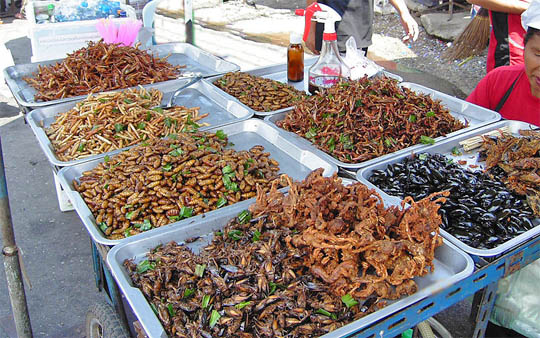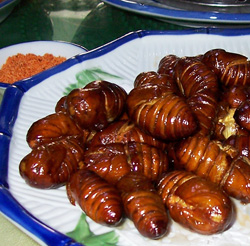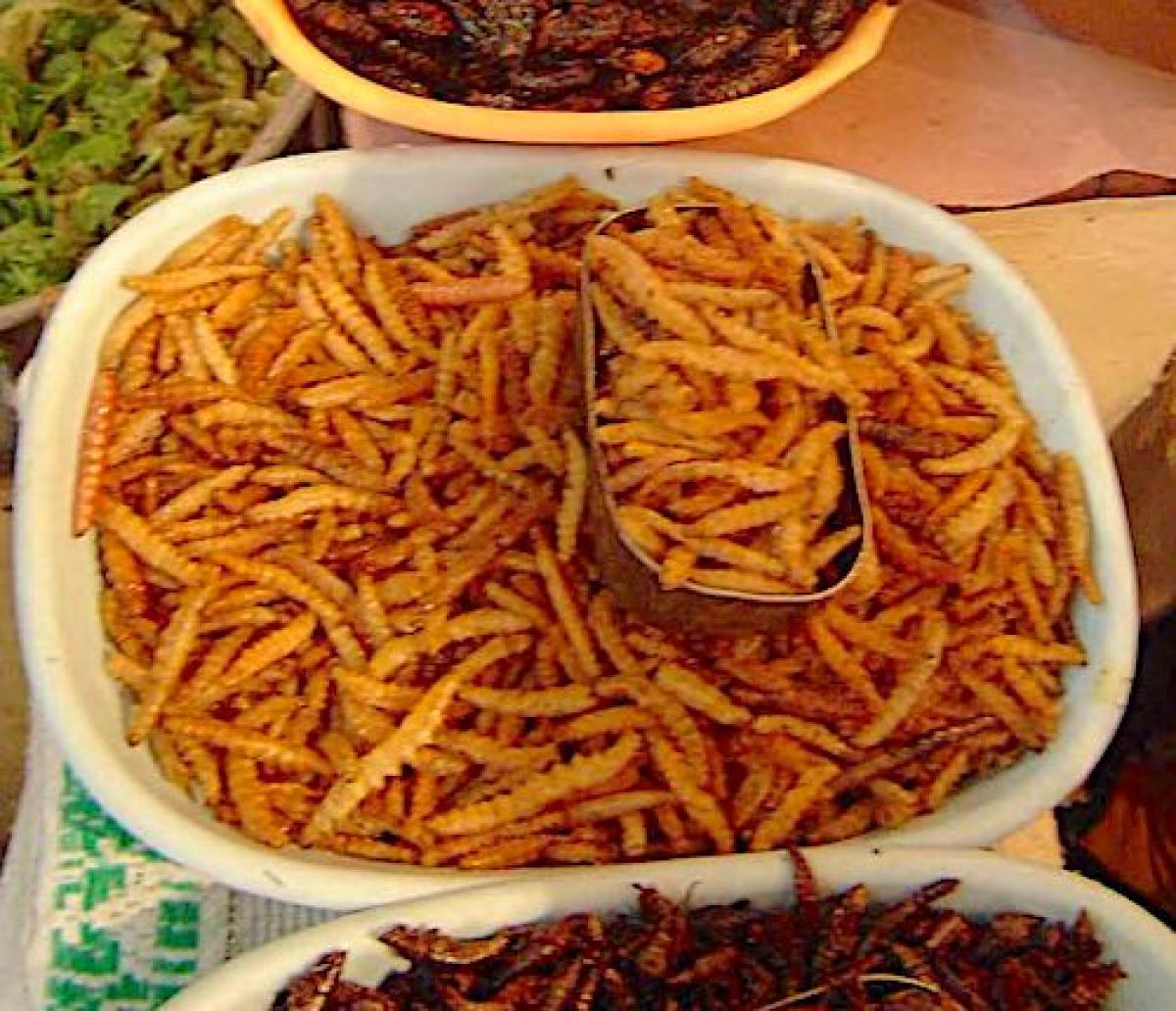
Illustrated by: Sabine Deviche
So you are sitting down for a meal, or maybe just thinking about what to make for dinner. What sounds good to eat? Maybe you want a stir-fried dish of bees? If you have a sweet tooth, you might want to try some chocolate covered crispy treats. Maybe you don't want to know what gives this treat its crunchiness, but they have been called delicious.
Even though these may not be your typical foods they are nutritional. They have protein and fats that we need to live. In fact, there are some countries where a good dish of insects is just the perfect meal. From tasty ants to grasshoppers and delicious grub worms, many cultures eat insects as part of their diet.

Let’s Eat Insects!

When traveling to study scarab biodiversity, I have tasted the delights of a few cultures – leaf cutter ants in the markets of Chiapas, Mexico (sold like popcorn in greasy paper bags), Mopani worms (always enjoyed with a cold coke) sold in the super markets of South Africa, and ants found right in the middle of the Great Plains (taste just like lemonade)!
Insects are an important food source throughout the world, and they are an ecologically sound food source as well. South African children collect grasshoppers of on the way home from school and are getting a high protein and high calorie snack. Two grasshoppers pack more protein than a quarter pound of hamburger! Insects are delicious and nutritious.
Insects - a High-protein, Calorie-rich Snack!
|
Calories (kcal) |
Proteins (g) |
|
|
Lean beef / 100 g |
219 |
27.4 |
|
Chicken / 100 g |
166 |
31.6 |
|
Pork / 100 g |
333 |
25.8 |
|
Fish / 100 g |
170 |
28.5 |
|
Caterpillars / 100 g |
376 |
28.2 |
|
Termites / 100 g |
613 |
14.2 |
|
Grasshoppers / 100 g |
200 |
20.6 |
So You Think Insects Are Yucky?
 American mouth-watering delicacies include a butter-soaked Atlantic lobster, spicy crayfish etoufee, and sweet Dungeness crab. Their kin, the insects, are no different! Three inch long water bugs, favorites in Asia, are prepared and eaten the same way Americans prepare and eat lobster. The sea-dwelling relatives of the insects feed on dead stuff at the bottom of the ocean. Compare this to caterpillars that feed on clean, green leaves; grasshoppers that feed on native prairie grasses; bee larvae that are fed pure flower nectar; and nutty-tasting larvae that feed on whole grains.
American mouth-watering delicacies include a butter-soaked Atlantic lobster, spicy crayfish etoufee, and sweet Dungeness crab. Their kin, the insects, are no different! Three inch long water bugs, favorites in Asia, are prepared and eaten the same way Americans prepare and eat lobster. The sea-dwelling relatives of the insects feed on dead stuff at the bottom of the ocean. Compare this to caterpillars that feed on clean, green leaves; grasshoppers that feed on native prairie grasses; bee larvae that are fed pure flower nectar; and nutty-tasting larvae that feed on whole grains.
An Unusual Way to Reduce Your Carbon Footprint?
Think about where you get your protein! Which protein source -- beef filet, chicken drumstick, or loin of caterpillar – is better for the environment? In livestock terminology, the Efficiency of Conversion of Ingested Food (ECI), or the amount of weight an animal gains per weight of food an animal eats, is an important consideration in range management. Here are some interesting comparisons:
|
Beef cattle (grass fed in the pasture) |
3 pounds of meat produced for every |
|
Beef cattle (grain fed in the feed lot) |
5 pounds of meat produced for every |
|
Chickens |
30 pounds of meat produced for every |
|
Pigs |
11 pounds of meat produced for every |
|
Grasshoppers |
10-15 pounds of meat produced for every |
|
Silkworm caterpillars |
26-35 pounds of meat produced for every |
Make Your Own Insect Dishes
I too have some recipes of the six-legged type that I like to make for special events. I have shared some of my favorites with Ask A Biologist and Dr. Biology. You might like to try them out when you have your next pot-luck dinner, or maybe a school event – with the permission of your teacher of course.
Bon appetit.
About the author: Mary Liz Jameson is an evolutionary biologist at Wichita State. She conducts faunistic research on scarab beetles (nationally and internationally), ecological research on dung beetles and carrion beetles, and conservation research on the endangered American Burying Beetle (Nicrophorus americanus). Listen to the Been there Dung That podcast to hear more about Dr. Jameson's research and her curious cookbook of insect dishes.
References:
Additional images via Wikimedia.
Berenbaum. 1995. Bugs in the System: Insects and Their Impact on Human Affairs; http://www.planetscott.com/babes/nutrition.asp
The Food Insects Newsletter http://foodinsectsnewsletter.org/
Read more about: Six-legged Recipes
Bibliographic details:
- Article: Six-legged Recipes
- Author(s): CJ Kazilek, Mary Liz Jameson
- Publisher: Arizona State University School of Life Sciences Ask A Biologist
- Site name: ASU - Ask A Biologist
- Date published: 4 Apr, 2011
- Date accessed:
- Link: https://askabiologist.asu.edu/explore/six-legged-recipes
APA Style
CJ Kazilek, Mary Liz Jameson. (Mon, 04/04/2011 - 10:18). Six-legged Recipes. ASU - Ask A Biologist. Retrieved from https://askabiologist.asu.edu/explore/six-legged-recipes
Chicago Manual of Style
CJ Kazilek, Mary Liz Jameson. "Six-legged Recipes". ASU - Ask A Biologist. 04 Apr 2011. https://askabiologist.asu.edu/explore/six-legged-recipes
CJ Kazilek, Mary Liz Jameson. "Six-legged Recipes". ASU - Ask A Biologist. 04 Apr 2011. ASU - Ask A Biologist, Web. https://askabiologist.asu.edu/explore/six-legged-recipes
MLA 2017 Style

Tasty grub worms at a local street vendor in Thailand.
Be Part of
Ask A Biologist
By volunteering, or simply sending us feedback on the site. Scientists, teachers, writers, illustrators, and translators are all important to the program. If you are interested in helping with the website we have a Volunteers page to get the process started.

